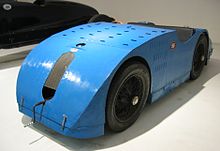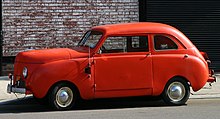
Ponton or pontoon styling is an automotive design genre that spanned roughly from the 1930s-1960s, when pontoon-like bodywork enclosed the full width and uninterrupted length of a car body — eliminating previously distinct running boards and articulated fenders.[1] The integrated fenders of an automobile with ponton styling may also be called pontoon fenders, and the overall trend may also be known as envelope styling. [2][3]
Now largely archaic, the term ponton describes the markedly bulbous, slab-sided configuration of postwar European cars, including those of Mercedes-Benz, Opel, Auto Union, DKW, Borgward,[4] Lancia, Fiat, Rover, Renault, and Volvo—as well as similar designs from North America and Japan, sometimes — in its most exaggerated usage — called the "bathtub" look in the U.S.[5]
The term derives from the French and German word ponton, meaning 'pontoon'.[6] The Langenscheidt German–English dictionary defines Pontonkarrosserie as "all-enveloping bodywork, straight-through side styling, slab-sided styling."[7]
- ^ Prokesch, Alfred (1980). Knaurs grosses Buch vom Auto: Geschichte, Modelle, Technik von A - Z title Ar (in German). Droemer Knaur. ISBN 978-3-85886-089-7.
- ^ Flink, James J. (1990). The Automobile Age. MIT Press. p. 246. ISBN 978-0-262-56055-9. Retrieved 23 March 2022 – via Google Books.
The Model B-A's "envelope body," a styling feature previously incorporated in the postwar Kaiser-Frazer cars ...
- ^ Foster, Patrick R. (2013). American Motors Corporation: The Rise and Fall of America's Last Independent Automaker. Motorbooks. p. 67. ISBN 978-0-7603-4425-5. Retrieved 23 March 2022 – via Google Books.
The new cars featured clean lines with smooth envelope-style bodies on a lengthened 112-inch wheelbase...
- ^ Braess, Hans-Hermann; Seiffert, Ulrich (2007). Automobildesign und Technik: Formgebung, Funktionalität, Technik. Vieweg+Teubner Verlag. p. 248. ISBN 978-3-8348-0177-7.
- ^ "Queen of the Bathtub Era: The 1949-51 Nash Airflyte". Mac's Motor City Garage. Retrieved 23 August 2022.
- ^ Haajanen, Lennart W.; Ludvigsen, Karl; Nyden, Bertil (2002). Illustrated Dictionary of Automobile Body Styles. McFarland. p. 109. ISBN 978-0-7864-1276-1.
- ^ Langenscheidt Dictionary Technology and Applied Sciences English-German. Langenscheidt Fachverlag. 2004. p. 1371. ISBN 978-3-86117-233-8. Retrieved 21 February 2014.
Pontonkarrosserie






